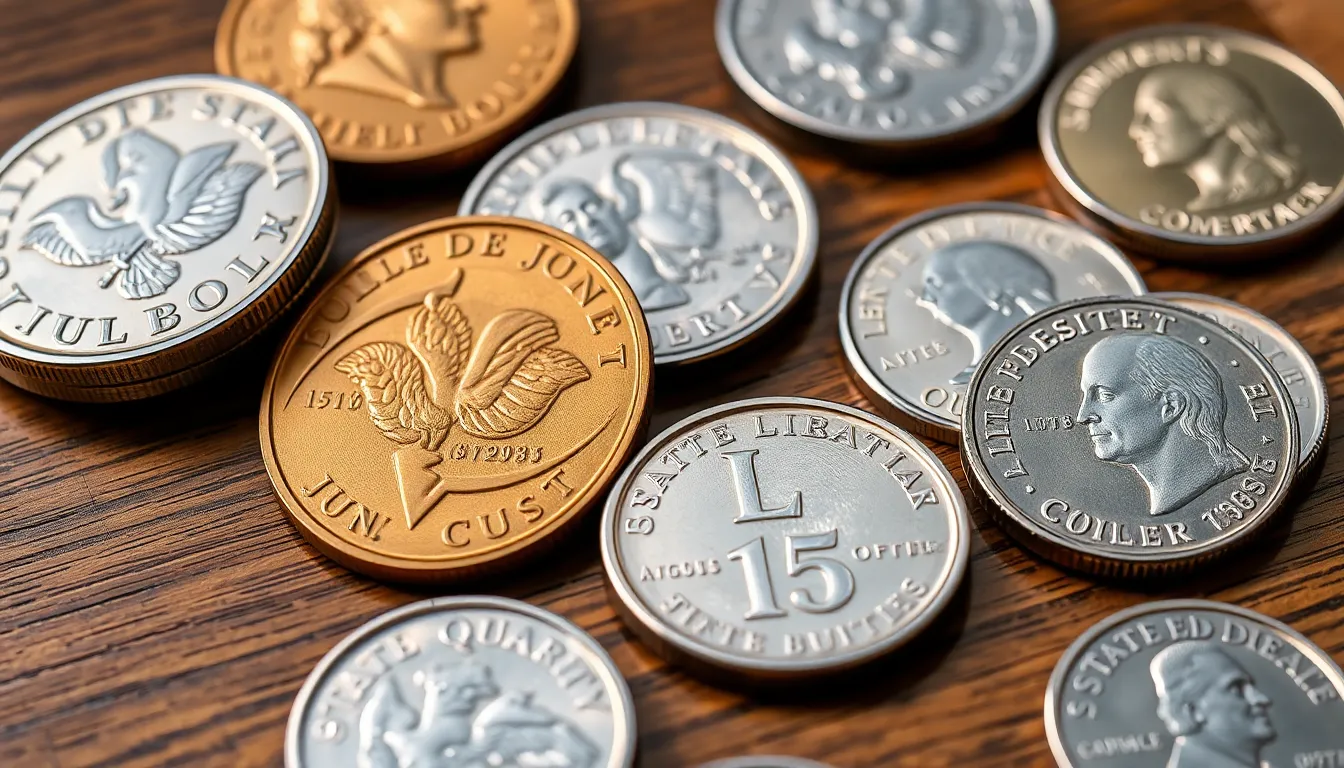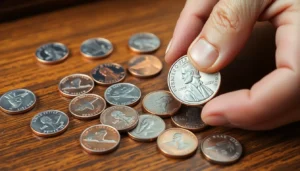Table of Contents
ToggleIn a world where wallets are often stuffed with crumpled receipts and forgotten gum, modern coins are sneaking in as unexpected treasures. Who knew that a shiny quarter or a funky penny could turn into a mini goldmine? It’s time to dig through those pockets and couch cushions because some of those coins might be worth more than a trip to the coffee shop.
Understanding Modern Coins
Modern coins refer to those produced after 1965. Collectors often overlook these coins, yet many carry significant value. Their worth may stem from rarity, historical significance, or unique minting errors.
Definition of Modern Coins
Modern coins include denominations like the quarter, nickel, dime, and penny minted in the United States. Coins produced post-1965 are considered modern due to changes in composition and design. For instance, copper-nickel alloys replaced silver coins, impacting their market value. Each coin type, such as commemoratives or special editions, comes with its own characteristics important for valuation.
Importance of Collecting Modern Coins
Collecting modern coins offers more than just an investment opportunity. This hobby fosters a connection to history and culture, enhancing appreciation for numismatic art. Many collectors discover how small denominations, like state quarters, can appreciate over time. Additionally, community events and online forums provide spaces for collectors to exchange knowledge and expand their collections. Understanding which modern coins hold value can lead to successful discoveries.
Types of Modern Coins Worth Money

Modern coins can hold significant value, especially for those aware of what to look for. Various types of coins stand out in the collectors’ market due to rarity, limited releases, or unique characteristics.
Rare Mint Errors
Rare mint errors attract collectors due to their scarcity. Coins with double die or off-center strikes can fetch high prices. Examples include the 2000-P Sacagawea dollar with a known error, valued at thousands. Identifying these errors requires careful inspection, so examining coins closely increases the chances of discovering valuable specimens.
Limited Edition Releases
Limited edition releases often pique interest among collectors. U.S. Mint products, like the annual Apollo 11 commemorative coins, showcase themes that resonate deeply with collectors. Scarcity drives their market value, with some pieces selling for significantly more than their face value. By staying updated on upcoming releases, collectors can capitalize on these opportunities for investment.
Popular Coin Series
Popular coin series consistently draw attention and demand. The State Quarters program, launched in 1999, sparked widespread collecting among enthusiasts. Each state quarter features unique designs, providing both sentimental and monetary value. Collectors often seek rare dates or special editions within these series, giving them a potential increase in value over time.
Factors That Determine Value
Several factors contribute to the value of modern coins. Understanding these elements aids collectors in identifying potentially valuable pieces.
Demand and Rarity
Collectible coins gain value from their demand and rarity. High demand often arises from collectors seeking specific varieties or historical significance. When a coin is rare and highly sought after, it commands a premium price in the market. The market fluctuations influenced by trends in collecting can also impact demand. For instance, a rare mint error can create significant interest, leading to increased offers. Coins like the 2000-P Sacagawea dollar exemplify how rarity can directly correlate with market value. As more collectors enter the space, the demand for certain coins may increase, further elevating their worth.
Condition and Grading
Condition plays a crucial role in determining a coin’s value. Coins in excellent condition are more desirable and command higher prices. Grading systems assess the physical state of coins and determine their quality. Collectors often rely on established grading scales, such as the Sheldon Scale, to evaluate condition consistently. Coins graded at higher levels, like MS (Mint State) or PR (Proof), typically fetch more in sales. Collectors should prioritize obtaining coins with fewer blemishes or signs of wear. Understanding how grading impacts value is essential in the collecting journey.
How to Spot Valuable Modern Coins
Identifying valuable modern coins involves recognizing key factors that contribute to their worth. Collectors need to examine specific features that signal potential value.
Key Features to Look For
Look for mint marks that indicate where a coin was produced. Coins manufactured in limited quantities often command higher prices. Assess the condition and grading of the coin; those in uncirculated or near-mint condition tend to be more desirable. Search for unique characteristics or errors during the minting process, such as double strikes or off-center coins. Collectors should pay attention to the design and any variations within popular series. Demand often drives value, making certain themes and historical events more sought after. Familiarity with these key features can enhance a collector’s ability to spot valuable coins.
Resources for Coin Evaluations
Online databases provide valuable insights into coin values, including platforms like PCGS and NGC. Collectors benefit from price guides that track market trends over time. Engaging with local coin shops offers the opportunity for expert evaluations and recommendations. Social media groups and online forums enable collectors to ask questions and share knowledge. Auctions can also reveal how much buyers are willing to pay for specific coins. Books on numismatics and coin collecting contain essential information, aiding in coin evaluations. Utilizing these resources makes the search for valuable modern coins more informed and efficient.
Selling Modern Coins
Selling modern coins involves several avenues that can help collectors achieve fair prices for their items. Recognizing the best platforms to use can make a significant difference in profitability.
Best Places to Sell
Collectors find several effective channels for selling their modern coins. Online marketplaces like eBay offer broad reach and convenience for sellers. Coin-specific websites or forums cater to a dedicated audience, increasing the chances of a successful sale. Local coin shops provide an immediate and personal selling experience, while coin shows present opportunities to connect with multiple buyers. Each platform has unique advantages; choosing the right one depends on the specific coin and target audience.
Tips for Maximizing Profit
Maximizing profit involves strategic actions that enhance selling potential. First, accurately grading coins affects pricing; understanding the Sheldon Scale helps determine value. Presenting coins professionally can attract buyer interest; consider using protective holders to display items. Researching recent sale prices for similar coins ensures competitive pricing. Implementing effective marketing, like high-quality photos and detailed descriptions, captures buyers’ attention. Patience often pays off; waiting for the right buyer can lead to better offers.
The world of modern coins holds unexpected treasures waiting to be discovered. With a little effort and knowledge collectors can uncover valuable pieces that enhance their collections and potentially yield significant returns. By understanding key factors like rarity condition and market demand collectors can make informed decisions about which coins to pursue.
Engaging with community resources such as local coin shops and online forums can further enrich the collecting experience. Whether it’s a rare mint error or a beloved state quarter modern coins offer a unique blend of history and investment potential. Embracing this hobby not only opens doors to financial opportunities but also deepens one’s appreciation for numismatic art and culture.






